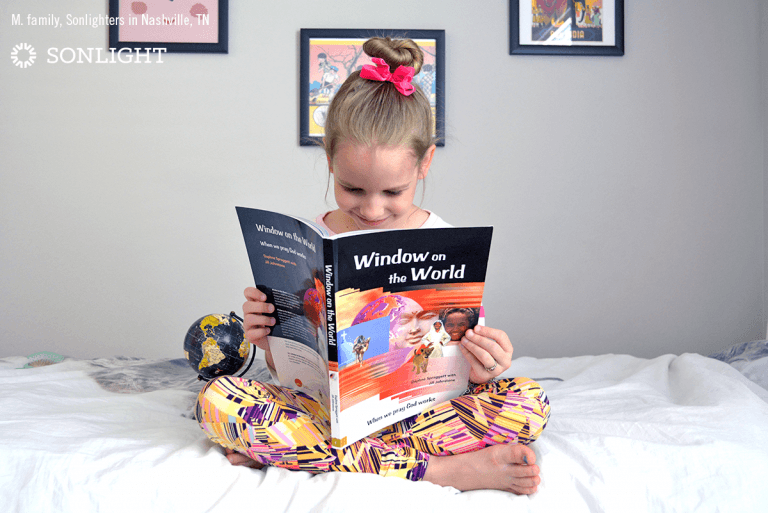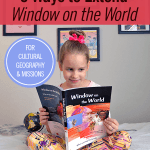See the world with Window on the World, a geography title in Sonlight's Intro to World History. And then go farther with these extension ideas for cultural literacy and missions.

Cultural geography takes on a life of its own, doesn’t it? It goes well beyond the facts of physical geography—such as landforms and bodies of water—and allows us to immerse ourselves in vibrant worlds beyond our own circle of familiarity. Cultural geography celebrates people, and draws us in to their incredibly varied stories. And that’s why I love Window on the World, the full-color narrative encyclopedia scheduled in History / Bible / Literature Level C and Level B+C—and why I love spending a little extra time on geography, too.
Of course, you don’t have to add to what Sonlight has scheduled; a Sonlight education is complete on its own. This isn’t about adding guilt to your already-full days. If you’ve got enough on your plate as it is, skip right on over this post, and don’t allow these ideas to make you feel like you’re not doing enough. (Mama, you are enough!) But if you and your geography-loving students want to dive in deeper, homeschooling with Sonlight definitely offers you flexibility.
So how can we take the geography infused throughout Sonlight and bring it to life even more?
1. Attend Local Cultural Festivals
So much of the world is truly right at our doorsteps, and cultural celebrations such as Lunar New Year, the Highland Games, or Midsummer bring the world even closer to home. Wandering through a cultural festival is a completely immersive experience, and adds so much to static images on a page. The music alone makes a cultural festival worth attending! And I love watching live performances like shadow puppetry or traditional folk dancing.
If you have the chance to attend a similar event, don’t pass up the opportunity—and be sure to sample the delicious food, too. What’s available near you depends on your area, but even when we lived in a small town in the rural Midwest, we were able to celebrate Hmong New Year with our community.
2. Listen to World Music
No cultural festival where you are? Create the atmosphere yourself, and listen to some world music! Since the wide variety of popular music available makes it difficult and time-consuming to find a representative sample when searching from scratch, I like to use children’s songs to extend our geography lessons. I find YouTube works far better than online music streaming services. Use an online search term similar to “traditional [name of country, language, or culture] children’s songs”, and create your own playlist. (This is also a great way to get starting learning a new language!)
3. Learn Phrases in Other Languages
Even if you’ve already incorporated a full foreign language study into your homeschool day, you can still learn a few phrases in additional languages for the countries you study, such as “hello”, “Jesus loves you”, or the numbers one through ten.
Again, YouTube is an oft-overlooked treasure trove when it comes to language learning—searching phrases such as “learn numbers in [language] for kids” will give you a lot of options, even in more obscure languages. Want an extra challenge? Memorize this week’s memory verse in a different language! YouVersion’s Bible app for kids supports over two dozen languages.
4. Try New Ingredients and Recipes
Food fascinates me, particularly the difference in taste around the globe. Have you seen photographer Hannah Whitaker’s riveting photo essay on what children in various parts of the world eat for breakfast?
Tasting new foods allows you to experience culture in a way few other activities—short of actual travel—do. And in my experience, kids are more adventurous tasters than you might expect, especially if they are deeply involved in the creating the meal. Bring the meal full circle, and shop for ingredients in a specialty store outside your usual neighborhood.
5. Make Friends with Families from Cultures Other Than Your Own
The Bible is clear about the multicultural kingdom. Revelation chapter seven, verse nine provides us a glimpse of heaven, showing us “a great multitude no one could count, from every nation, tribe, people and language.”
Doesn’t it make sense the community of believers on earth should reflect this diversity? You don’t have to be serving abroad as a missionary to mingle cross-culturally. Festivals, language classes, and grocery stores are a good place to start. Of course, do not approach this with an attitude of condescension, but of genuine interest. (People are neither a spectacle nor a museum exhibit!)
And cultivate gratitude by learning the realities of many other countries, too. I find difficult stories to be especially formative!
6. Use Your Markable Map
I understand how tempting it is to leave out the map activities indicated in the Instructor’s Guide; after all, how much excitement and educational benefit can you glean from simply running a marker over a wet-erase map? But as my daughter’s experience with literature-based geography taught me, you can learn a tremendous amount by simply plotting the locations you read about. Mapping creates connections between faces and places, and transforms geography into a living entity, teeming with people.
And people are how it all comes together, and geography comes alive. So dive in to Window on the World with a refreshed perspective, and focus on the human thread connecting each dot on the map.
Curious to see what a literature-based, Christ-infused education might look like for your family? Go to SmoothCourse to explore your options.








